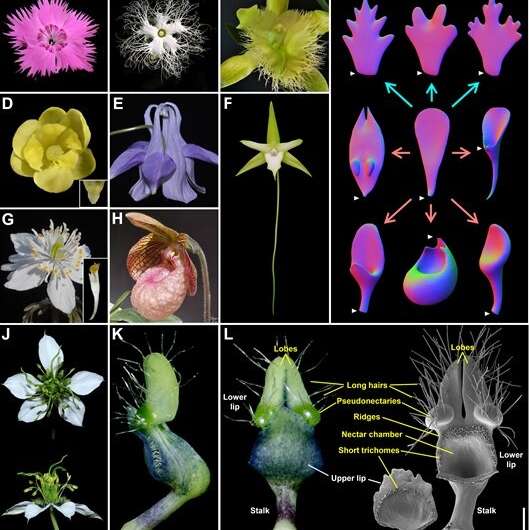Uncovering developmental mechanisms of elaborate petals in Nigella damascena

Researchers led by Dr. Kong Hongzhi from the Institute of Botany of the Chinese Academy of Sciences reported the mechanisms underlying elaborate petal development and specialized character formation in Nigella damascena, and the results were recently published in The Plant Cell.
Petals display spectacular arrays of diversity in size, shape, color and function. They can be simple or elaborate, depending on whether they have modifications along their margins or on their adaxial/abaxial side, or both. Elaborate petals are believed to have played key roles in the adaptive evolution of the corresponding lineages. Previous studies have shown that elaborate petals can be made through marginal and/or ventral elaborations, as well as the formation of some specialized morphological characters. The mechanisms underlying the formation of elaborate petals, however, are largely unclear.
Petals of Nigella damascena (Ranunculaceae) have long been recognized as being elaborate, possessing not only a stalked bilabiate basic structure but also several highly specialized morphological characters (e.g., long hairs, short trichomes, nectary, and pseudonectaries).
So, which genes or programs are required for the formation of elaborate petals in N. damascena and, of them, which are shared by, or different between, elaborate and simple petals?
With detailed time-course transcriptomic analyses, Kong and his team not only found the genes and programs that are specifically or preferentially expressed in N. damascena petals but also discerned those that are required for elaborate rather than simple petal development.
By correlating the expression patterns of genes and developmental changes of petals, they also identified 30 candidate genes that may play key roles in elaborate petal development (including the establishment of the bilabiate basic structure and the initiation of the aforementioned highly specialized morphological characters).
"We found that one of the candidate genes, NidaLMI1, whose counterparts in other species are involved in the formation of dissected leaves, tendrils or trichomes rather than petal development, appears to be indispensable for the initiation of short trichomes and the bifurcation of the lower petal lips," said Kong.
These results not only provide the first portrait of elaborate petal development, but also pave the way to understanding the mechanisms underlying lateral organ diversification in plants.
More information: Rui Zhang et al. Identification of the Key Regulatory Genes Involved in Elaborate Petal Development and Specialized Character Formation in Nigella damascena (Ranunculaceae), The Plant Cell (2020). DOI: 10.1105/tpc.20.00330
Journal information: Plant Cell
Provided by Chinese Academy of Sciences


















